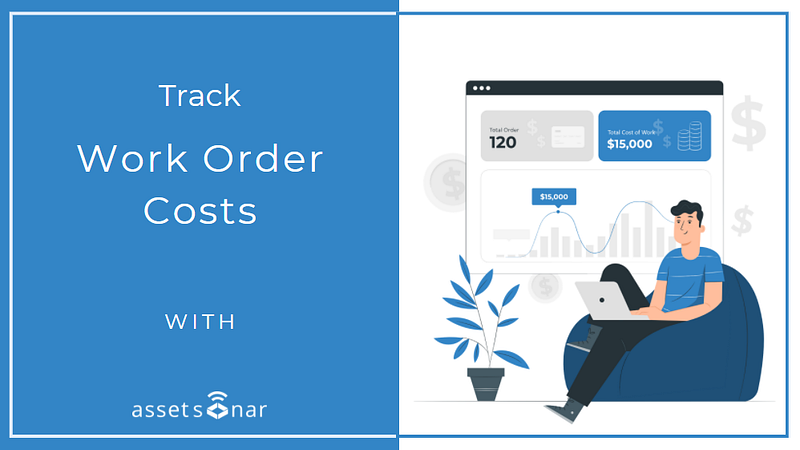Manually tracking your ITSM budget is a daunting task. Without an automated solution, keeping tabs on individual Work Orders and the cost of labor, consumables, and time associated with each Work Order can be challenging and time-consuming.
AssetSonar simplifies this process with its new feature — Work Order Costs. It enables you to input and monitor in real-time various costs associated with Work Orders so you can focus on optimizing your IT service management budget rather than worrying about calculating the total amount you spend on each maintenance task.
Contents
- Types of Work Order Costs
- Enable Work Order Costs
- Tracking costs of General Work Orders
3.1. Base Cost
3.2. Cost of Work - Tracking costs of Maintenance Work Orders
4.1. Base Cost
4.2. Cost of Consumed Inventory
4.3. Cost of Work
4.4. Service Cost - Customize List view of Work Order Costs
- Print costs of Work Orders
- Costs in Work Order reports
7.1. Work Order report
7.2. Linked Inventory report
7.3. Work Logs report - Dashboard KPIs
This article details the different types of Work Order Costs you can track and explains how you can create them within AssetSonar.
Let’s get started!
1. Types of Work Order Costs
There are four primary types of Work Order Costs you can monitor with AssetSonar.
- Base Cost: This is the estimated cost of completing a Work Order that you add while drafting a Work Order.
- Cost of Work: This refers to the total dollar amount you pay to employee(s) based on the number of hours they’ve put in for completing a Work Order.
- Cost of Consumed Inventory: This is the cost price of Inventory items that were used while servicing a Maintenance Work Order.
- Service Cost: This refers to the additional cost (beyond Base Cost) that you incur while servicing an Asset during a Maintenance Work Order.
Note that Costs 3 and 4 are particular to Maintenance Work Orders and do not apply to General Work Orders.
Additionally, if any of the cost types mentioned above equal $0, it will not show up in the Cost table of a Work Order.
2. Enable Work Order Costs
In order to start using Work Order Costs, you must first enable the feature from Settings → Add Ons → Work Order Costs. Select the costs you want to track for Work Orders and click ‘Update’.

Cost of Consumed Inventory and Cost of Work is dependent on this setting.
If you wish to restrict the visibility of Work Order Costs across Staff Users, you can select the option illustrated below.

Note: The Work Order Cost setting only appears if you have the Work Orders Add On enabled in your AssetSonar account.
3. Tracking Costs of General Work Orders
Now that Work Order Costs have been enabled, let’s begin with creating costs for a General Work Order.
Below, we show the example of a General Work for hardware updates on a laptop.
3.1. Base Cost
Configure the details and add Base Cost as shown.
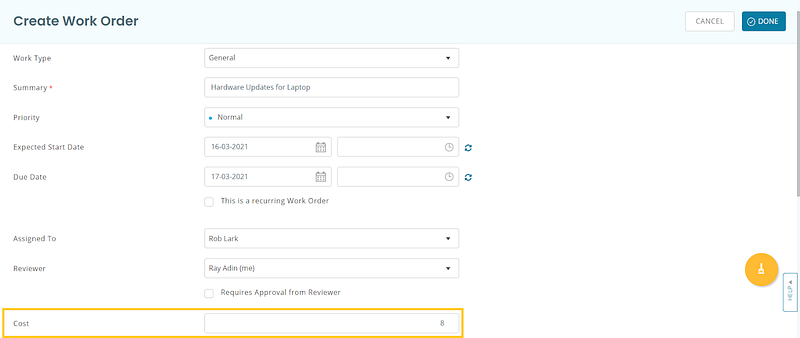
Link the relevant laptop (Asset) and hit ‘Done’.
The Base Cost will now appear in a Cost table on the Work Order Details page.
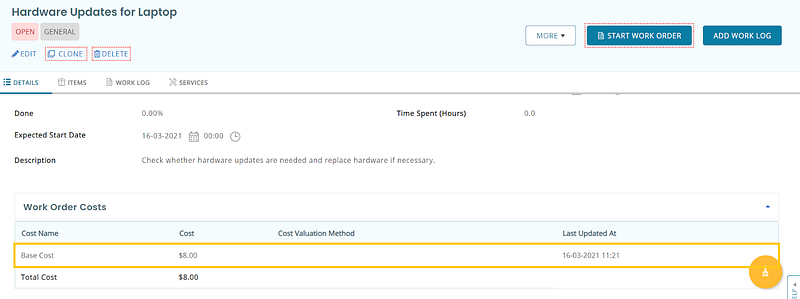
3.2. Cost of Work
Once the Work Order has been started, you can also add the Cost of Work associated with it.
Click on the ‘Add Work Log’ button from the Work Log tab.
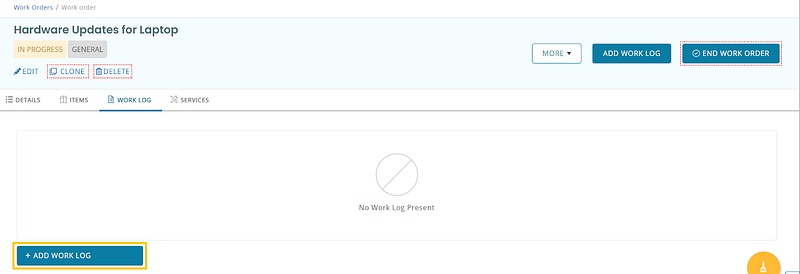
You can also add Work Logs directly from the Work Order Details page as shown.
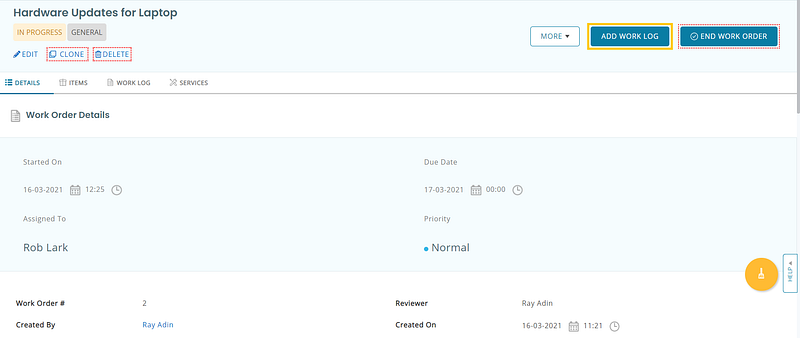
Mention details such as the assigned employee, pay per hour, and time taken to complete the task.
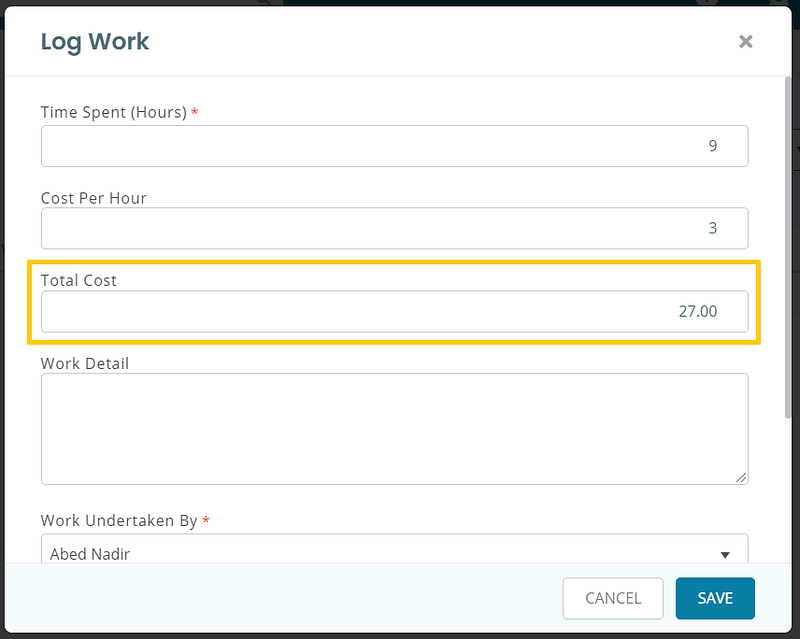
Once saved, it will show in the Cost table as follows.

Cost of Work can also be edited from the Work Log tab of a Work Order Details page.

4. Tracking Costs of Maintenance Work Orders
Let’s look at the example of a Maintenance Work Order now.
Suppose an employee sends a laptop to the IT department to get its battery and broken LED screen replaced. Since this task requires the use of inventory and some service on it, we’ll classify this as a Maintenance Work Order.
4.1. Base Cost
Base Cost is entered the same way as in Section 3.1.

4.2. Cost of Consumed Inventory
While creating the Maintenance Work Order, you can link Associated Assets and Inventory items to it as illustrated.

The Cost of Consumed Inventory is now visible in the Cost table.
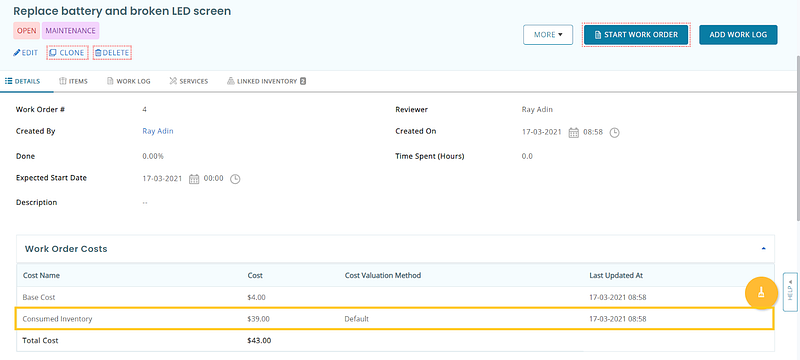
Note that the Cost of Consumed Inventory depends on the default costing method selected by a company to price its Inventory items. This setting can be accessed from Settings → Company Settings → Valuation & Costing Methods for Items → Inventory.
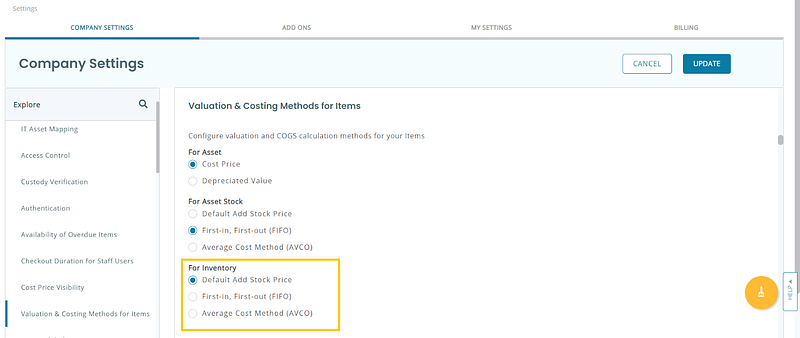
In this case, the Default Add Stock Price had been selected — as shown in the Cost Valuation Method column of the Cost table.
Note: The selected Inventory valuation method gets locked for a particular Maintenance Work Order at the time of its creation. If you change this setting at a later point in time, it will apply to all Maintenance Work Orders that are created thereafter.
You can view the detailed breakdown of Cost of Consumed Inventory, for instance, Cost per unit from the Linked Inventory tab.
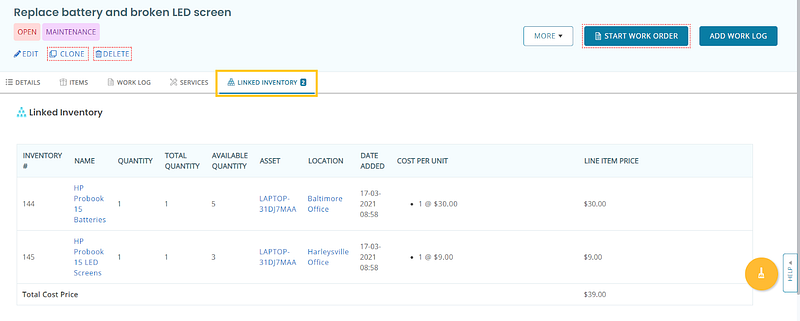
Pro tip!
There are four additional ways you can link Inventory items to Work Orders in order to account for the Cost of Consumed Inventory.
- Editing an Open Work Order: Go to an Open Maintenance Work Order, click ‘Edit’, and add/remove Inventory items as needed.
- From the Linked Inventory tab: Go to an In Progress Maintenance Work Order → Linked Inventory tab and click on the ‘+Link Inventory Items’ button. Note: You cannot remove Inventory items from a Work Order once it has started.
- From the Services tab: Go to an In Progress Maintenance Work Order → Services tab → Service → Linked Inventory and click on the ‘+Link Inventory Items’ button.
- Completing the service: Go to the relevant Asset Details page → Service → Complete → Add Inventory → Update Service.
4.3. Cost of Work
Cost of Work can be added the same way as in Section 3.2. You can view the Cost of Work from the Work Log tab.

4.4. Service Cost
Service Cost can be added from the Services tab of a Maintenance Work Order by clicking the ‘Edit’ icon under the Cost column.

Configure details, hit ‘Edit Cost’ and you can view the Service Cost as shown below.
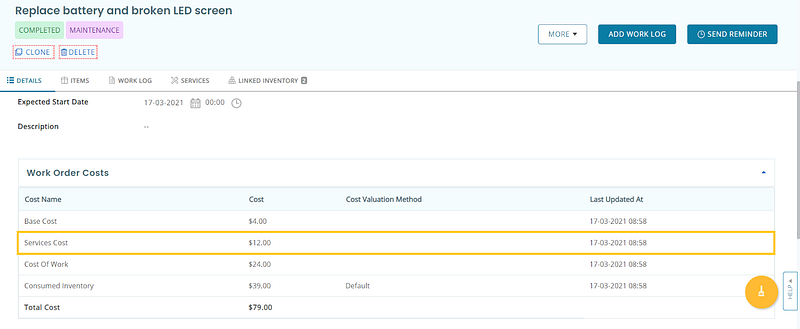
Note: In order to be able to edit Service Cost, you must first enable the setting from Settings → Company Settings → Service Edit and Deletion → Enabled.
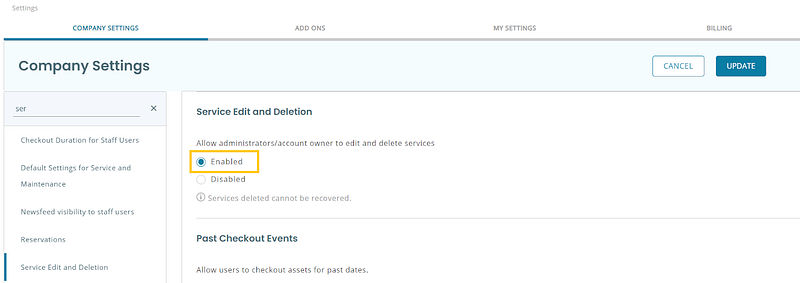
The Service must also be in the Completed state for the Service Cost to be editable.
5. Customize List view of Work Order Costs
AssetSonar also gives you the ability to customize the listing view of the Work Orders page so you can view Work Order Costs at a glance. To do so, click the ‘Edit’ button as shown.
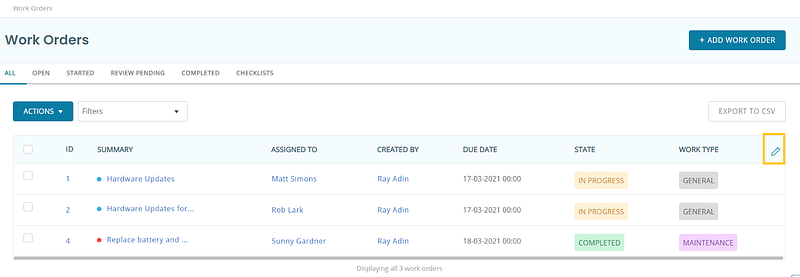
Select your preferred costs and save the listing view. You can now see extra columns added to the Work Order Listing page.

6. Print costs of Work Orders
Users can also print Work Order Costs that are visible to them by following the pathway: More → Printout Templates → Work Order → Start Designing Template.
This leads you to the Invoice Designer. Scroll below and you’ll see a section titled ‘Work Order Costs’. You can customize the table of Work Order Costs by clicking on the highlighted ellipsis.
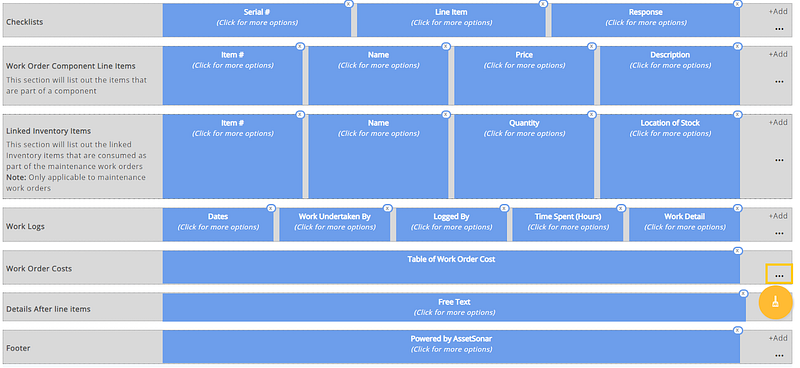
To print the Work Order Costs, go to the relevant Work Order Details page → More → Print Work Order. This is how a printed table of Work Order Costs shall look like:

You can also see additional details such as Consumed Inventory and Work Logs.
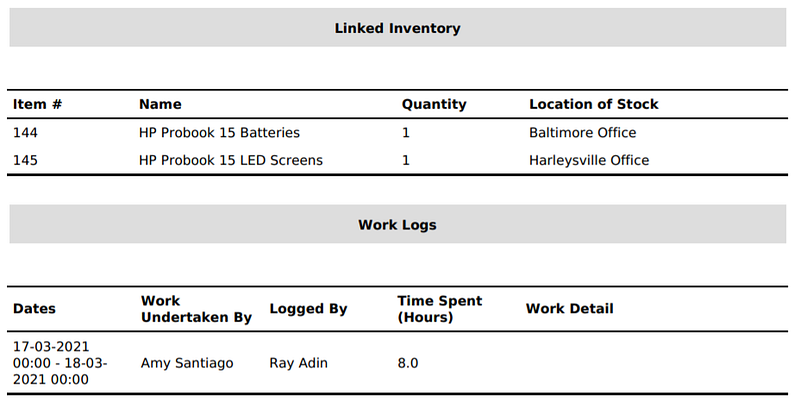
Printed Work Order Costs are a convenient way to share ITSM expense data with the senior management.
7. Work Order Costs in Reports
All Work Order reports display columns for costs that you have enabled in your AssetSonar settings. To run the reports, go to Reports → Work Order Reports from the dashboard.
7.1. Work Order report
The Work Order report shows additional columns for all the costs you have enabled and the Total Cost of a Work Order.
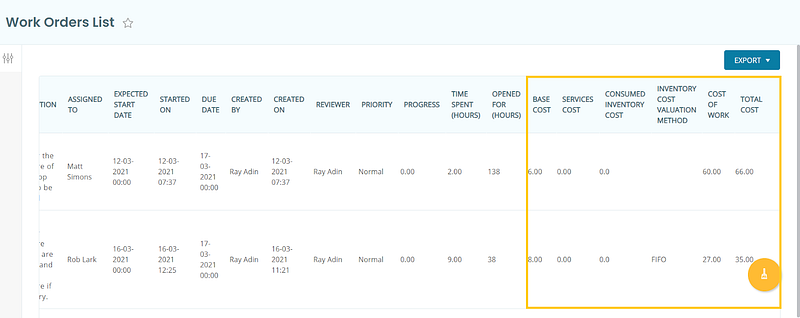
7.2. Linked Inventory report
The Linked Inventory report displays the Cost of Consumed Inventory and the Cost Valuation Method.

7.3. Work Logs report
The Work Logs report has extra columns for work log details, Cost of Work, and the Associated Asset.
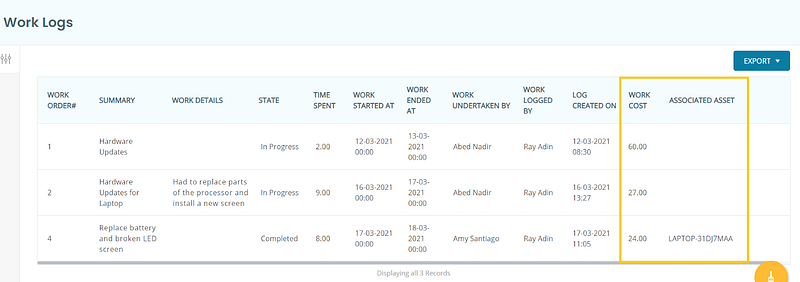
7.4. Custom reports
Once enabled, Work Order Costs can also be added as individual columns to Custom Reports if you have selected Works Orders as the primary module.
The example below shows Work Logs as the related module.
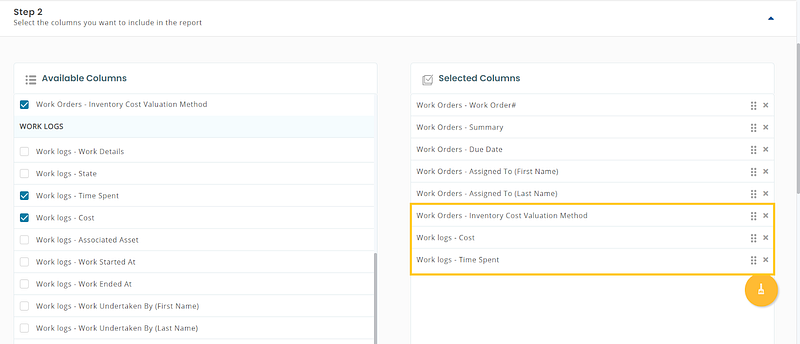
Note: You can either select Work Logs or Linked Inventory as a related module at a time.
8. Dashboard KPIs
Get instant access to Work Order information with our dashboard KPIs for Work Order Costs, including:
- The total cost of Completed Work Orders
- The total cost of In Progress Work Orders
Go to Dashboard → Edit → Add/Edit Widgets → Dashboard Settings, select your relevant Work Order Cost KPIs and hit ‘Done’.
This is how the selected KPIs will display on your dashboard.
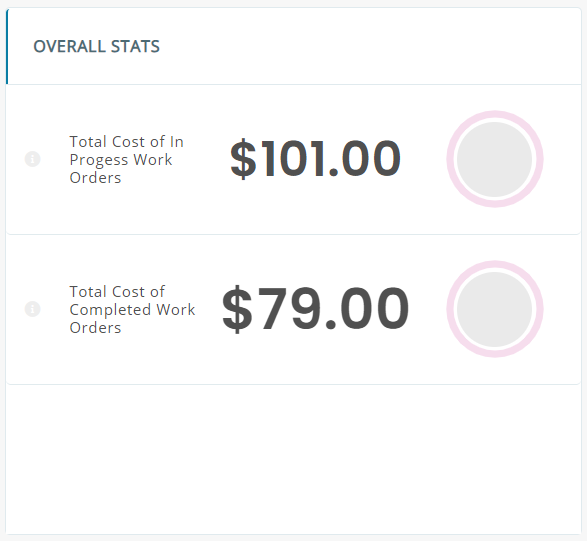
These KPIs give you a quick overview of your ITSM costs so you can optimize them as needed.
Read more: [How-to] create and track Work Orders in AssetSonar
About AssetSonar
AssetSonar is the leading hardware asset management software used by IT-intensive organizations and businesses all over the globe. Sign up today for a free 15-day trial.
For more assistance, drop us an email at support@ezo.io. You can also visit our blog for detailed support posts.


